groove-winged minute seed weevil
(Homorosoma sulcipenne)
Conservation • Description • Habitat • Ecology • Distribution • Taxonomy
|
|
||||||||||||||
Description |
Groove-winged minute seed weevil is a small beetle. It occurs in the Unites States and southern Canada east of the Great Plains. Based on the number of available records it is uncommon throughout its range. Adults are active in the spring and summer. They are found on knotweeds (Polygonum spp.). Adults are black, hard bodied, robust, oval, and 1⁄16″to ⅛″ (2.1 to 3.2 mm) in length. They are convex when viewed from the side. The entire body is densely covered with broad, flat scales. The head is greatly elongated between the eyes and the mouth parts form a conspicuous snout (rostrum). The rostrum is almost cylinder-shaped, projected forward, and slightly bent downward. It is more than three times as long as wide, much longer than the exoskeletal plate covering the thorax (pronotum), but shorter than the head and thorax combined. The antennae are short, slender, and sharply bent (elbowed). They have 11 segments and are inserted on the rostrum well away from the base. The last 3 segments are expanded and form a club, and there are 7 segments between the base of the antenna and the club. The thorax is composed of three segments. The first segment (prothorax) is large and prominent and appears to be the entire thorax. It is covered by the pronotum. The pronotum is slightly wider than long, strongly arched at the sides, and almost as wide at the base as the hardened wing covers (elytra). The rear exoskeletal plate (mesepimeron) on the side of the thorax is distinctly raised. The elytra do not cover the last segment of the body (pygidium). There is a short white stripe at the base of the midline (suture), where the two meet. The legs are black. There is a tooth on the lower side of third segment (femur) of all legs. The femurs on the hind leg is expanded, making the adult a good jumper. The fourth segment (tibia) on the hind leg has a small tooth at the tip. The last part of the leg (tarsus), corresponding to the foot, has 5 segments, but the fourth segment is very small and is concealed within the lobes at the end of the third segment, making it appear to have just 4 segments. At the end of the last tarsal segment there are two claws. On the hind leg there is a small tooth at the tip of the tibia. |
Size |
Total length: 1⁄16″to ⅛″ (2.1 to 3.2 mm) |
Similar Species |
Habitat |
Knotweeds (Polygonum spp.) |
Ecology |
Season |
Spring and summer |
Behavior |
|
Life Cycle |
|
Larva Food |
Stalks of knotweeds (Polygonum spp.) |
Adult Food |
Foliage of knotweeds (Polygonum spp.) |
Distribution |
||
|
Sources Biodiversity occurrence data published by: Minnesota Biodiversity Atlas (accessed through the Minnesota Biodiversity Atlas Portal, bellatlas.umn.edu, 7/4/2025). |
|
| 7/4/2025 | ||
Occurrence |
||
Uncommon? The scarcity of records for Homorosoma sulcipenne is likely due, at least in part, to it being overlooked because of its small size and its similarity in appearance to many other minute weevils. |
||
Taxonomy |
|
Order |
Coleoptera (Beetles) |
Suborder |
Polyphaga (Water, Rove, Scarab, Long-horned, Leaf, and Snout Beetles) |
Infraorder |
Cucujiformia |
Superfamily |
Curculionoidea (snout and bark beetles) |
Family |
Curculionidae (true weevils) |
Subfamily |
Ceutorhynchinae (minute seed weevils) |
Tribe |
Scleropterini |
Genus |
Homorosoma |
Subordinate Taxa |
|
|
|
Synonyms |
|
Homorosoma sulcipennis |
|
Common Names |
|
groove-winged minute seed weevil |
|
Glossary
Elytra
The hardened or leathery forewings of beetles used to protect the fragile hindwings, which are used for flying. Singular: elytron.
Femur
On insects and arachnids, the third, largest, most robust segment of the leg, coming immediately before the tibia. On humans, the thigh bone.
Pronotum
The exoskeletal plate on the upper side of the first segment of the thorax of an insect.
Rostrum
The stiff, beak-like projection of the carapace or prolongation of the head of an insect, crustacean, or cetacean.
Tarsus
On insects, the last two to five subdivisions of the leg, attached to the tibia; the foot. On spiders, the last segment of the leg. Plural: tarsi.
Tibia
The fourth segment of an insect leg, after the femur and before the tarsus (foot). The fifth segment of a spider leg or palp. Plural: tibiae.
Visitor Photos |
||
Share your photo of this insect. |
||
This button not working for you? |
||
Alfredo Colon |
 |
MinnesotaSeasons.com Photos |
||
|
||
|
||

Slideshows |
|

Visitor Videos |
||
Share your video of this insect. |
||
This button not working for you? |
||
|
Other Videos |
||
|

Created: 7/11/2021 Last Updated: © MinnesotaSeasons.com. All rights reserved. |


